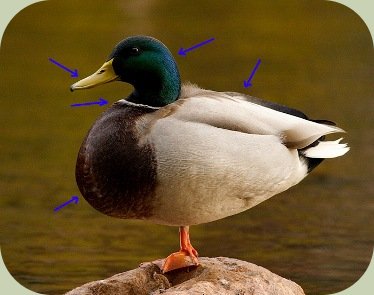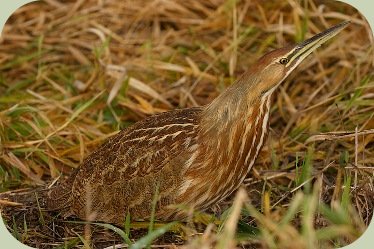Identification of Wild Birds
Identification of wild birds is a truly gratifying endeavor. Of all the wildlife out there, birds are some of the most fascinating and most easily observed. Their amazing colors and patterns, as well as their interesting behaviors can be a delight to see. Though, with over 800 species that can be seen in North America it can be very overwhelming when trying to identify wild birds.
If you do not already own them, purchasing some good field guides is the first step for the identification of wild birds. There are some excellent guides out there, such as Sibley's, Peterson's and National Geographic Field Guide to Birds. These guides all show birds in common poses with some slight varying degrees of detail and emphasis. Compare them and find one that fits your needs best.
When you are learning to identify wild birds, it helps to keep the following categories in mind: 1) Size and Shape, 2) Field Marks, 3) Behavior, and 4) Location. These categories don't have to be used in this order, but it certainly can help make this process easier and more effective.
Shape and Size for the Identification of Wild Birds
The first thing most birders notice when observing a bird is the overall shape and size. Try to relate the bird you see to birds you might be familiar with. For instance, is the bird robin-sized, crow-sized or chicken-sized? Once you get the overall size, you might look at the shape. Is the bird built short, squat with short legs and a small head with a short bill? Or is it tall and skinny, with long legs, a long neck and a long, pointed bill?
Field Marks for the Identification of Wild Birds
This is the next step in the identification process. These are marks that help identify wild birds via there specific markings and physical features. Is its tail long, or short, rounded or pointed? Does it have a speckled breast, an eye stripe or wing bars? Are its wings short and rounded, or long and pointed? Are its legs long and skinny, or short and powerful?
Notice the arrows in the photo of the mallard. They point to some of the field marks that help distinguish this common bird from other similar ducks. The yellow bill, green head, neck ring, brown chest and pale body help identify this bird as a male mallard.

Perhaps more so than any other feature, a birds bill shape and size can be a great asset when we are trying to identify wild birds. Does it a have a powerful, hooked bill like a bird of prey? Or is its bill long, and spear shaped like a heron's? Looking closely at the birds bill will naturally lead you into the third category in identifying wild birds.
Behavior for the Identification of Wild Birds
How a bird behaves provides vital clues to helping us identify wild birds. Does the bird hop around on the ground and scratch in the leaves, like towhee? Does the bird sit patiently on telephone poles or soar in big circles in the sky, like a red-tailed hawk? What is the bird doing? It helps to take at least quick notes on what you observe the bird or birds doing.
Songs and calls are a specific kind of bird behavior that are vital to help identify wild birds. First, is the bird you are watching making any sounds? Some birds are quiet most of the time. Pay attention to when you do hear a bird make a sound, and notice its quality. Is its voice very high and thin, like a kinglet or low and booming, like a grouse? Does it have a beautiful, ethereal song like a thrush? Or a harsh, croaking call like a great blue heron?
Behavior is dictated in large part by a birds dietary preferences. You would not see a bald eagle eating bird seed out of a neighborhood feed and you would also not see a house finch or junco snatching a salmon out of a river. Each bird has its own place in the food chain, and has a body adapted to that food source. Which brings us to the last category to consider.
Be More Prepared For Your Next Outdoor Adventure!

Don't leave home without knowing these six essential survival skills. Our free survival mini guide reveals the strategies of:
- Shelter & fire to prevent the number one cause of death
- Obtaining clean water to avoid life-threatening dehydration
- Common wild survival foods and other critical skills!

Location as a Tool for the Identification of Wild Birds
Last but not least, notice the location where the bird that your are observing. When you are learning to identify wild birds, it is helpful to know what habitats those birds use. Is the bird you are observing wading through the shallows of a wetland as a heron might do? Is the bird hopping around on the ground and scratching under the leaf litter along the edge of a hedgerow the way a towhee does? Is the bird in a mature forest of mixed woods as a pleated woodpecker might be?
Some birds have more specific habitat needs than others. The great horned owl (Bubo virginianus) is found in woods, fields, plains, forest edges, canyons and deserts. Meanwhile, the American bittern (Botaurus litigious) seen in the photo below, is practically never seen outside the tall grasses and rushes of fresh and saltwater marshes.

Putting all of these observations together can greatly increase your success in learning to identify wild birds around you. These categories are even more effective when coupled with the use of a good field guide.
By the way, when you're out birding, it's important to know how to stay safe in the outdoors, especially if you were to get lost. Right now you can get a free copy of our mini survival guide here, where you'll discover six key strategies for outdoor emergencies, plus often-overlooked survival tips.
Resources:
There are also some great online field guides that can help in your search:
Identification of Wild Birds in Washington State
Identify Wild Birds Across North America
Related Courses:
Wildlife Tracking Courses at Alderleaf

About the Author: Filip Tkaczyk is a periodic guest teacher at Alderleaf. He also wrote the field guide Tracks & Sign of Reptiles & Amphibians. Learn more about Filip Tkaczyk.
Return from Identification of Wild Birds back to Birding Articles
Is The Essential Wilderness Survival Skills Course Right for You? Take the "Online Survival Training Readiness" Quiz
See for yourself if this eye-opening course is a good fit for you. It takes just a few minutes! Get your Survival Training Readiness Score Now!

Grow Your Outdoor Skills! Get monthly updates on new wilderness skills, upcoming courses, and special opportunities. Join the free Alderleaf eNews and as a welcome gift you'll get a copy of our Mini Survival Guide.

 The Six Keys to Survival: Get a free copy of our survival mini-guide and monthly tips!
The Six Keys to Survival: Get a free copy of our survival mini-guide and monthly tips!
Learn more